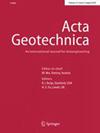A coupled hydro-mechanical field-enriched finite element method for simulating the hydraulic fracture process of rocks subjected to in situ stresses
Abstract
A coupled hydro-mechanical field-enriched finite element method (HM-FE-FEM) is developed for simulating the hydraulic fracture process of rocks subjected to in situ stresses. The staggered iterative scheme based on the Newton–Raphson iterative algorithm is utilized to address the coupled hydro-mechanical problems. The opening process of the hydraulic fracture and natural fracture subjected to in situ stresses can be reproduced by the proposed method. The accuracy of the proposed method is verified through stress intensity factor, fracture opening and experiment results. For coalescence patterns between hydraulic and natural fractures, the influences of horizontal stress difference and intersection angle are analyzed and discussed. Additionally, for coalescence patterns between hydraulic fracture and natural karst caves, the influences of cave location, cave radius and horizontal stress difference are investigated and discussed. The numerical results illustrate the effectiveness of HM-FE-FEM in handling the complex coalescence behaviors in the hydraulic fracture process of underground rock reservoirs with different defects. This study has a certain guiding significance for optimizing the fracturing operation parameters.

 求助内容:
求助内容: 应助结果提醒方式:
应助结果提醒方式:


